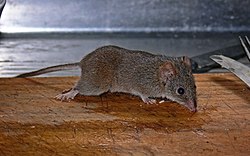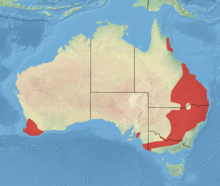Yellow-footed antechinus
| Yellow-footed antechinus | |
|---|---|
 |
|
| Scientific classification | |
| Kingdom: | Animalia |
| Phylum: | Chordata |
| Class: | Mammalia |
| Infraclass: | Marsupialia |
| Order: | Dasyuromorphia |
| Family: | Dasyuridae |
| Genus: | Antechinus |
| Species: | A. flavipes |
| Binomial name | |
|
Antechinus flavipes (Waterhouse, 1838) |
|
| Subspecies | |
 |
|
| Distribution of the yellow-footed antechinus | |
The yellow-footed antechinus (Antechinus flavipes), also known as the mardo, is a shrew-like marsupial found in Australia. One notable feature of the species is its sexual behavior. The male yellow-footed antechinus engages in such frenzied mating that its immune system becomes compromised, resulting in stress related death before it is one year old.
The yellow-footed antechinus was described in 1838 by George Robert Waterhouse, who noted its most distinctive feature in its species name flavipes, which means "yellow-footed". The species has occasionally been combined with the brown antechinus (A. stuartii).
A member of the family Dasyuridae, the yellow-footed antechinus is the most widespread of all the members of its genus, Antechinus.
Three subspecies of the yellow-footed antechinus are recognised:
The yellow-footed antechinus has a variable fur colour, but is generally somewhat greyish. Other notable features include a white eye-ring and a black tip to the tail. It has a pointed muzzle and short, broad feet of buff to yellow-brown color, hence the name. It has short hair and a moderately long tail. In size and body shape this species is fairly typical of its genus. Head and body length about 10–13 cm (4–5 in); weight about 30 g (1.1 oz).
The yellow-footed antechinus differs from its relatives in its comparatively diurnal habits. The mating season lasts for two weeks either in August, for southern animals; in October, for animals from southern Queensland; or in June–July, for north Queensland animals. The diet is invertebrates, eggs, nectar and sometimes small vertebrates.
The yellow-footed antechinus is found discontinuously from around the Mount Lofty Ranges in South Australia to around Eungella in Queensland, with the exception of most of coastal New South Wales and Victoria. Isolated populations occur in northeastern Queensland and in southwestern Western Australia. Some populations are listed as "locally common", others as uncertain.
...
Wikipedia

